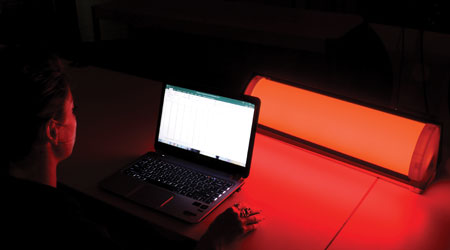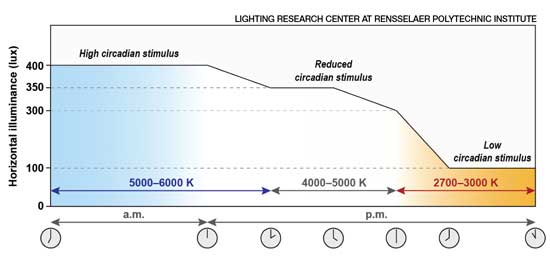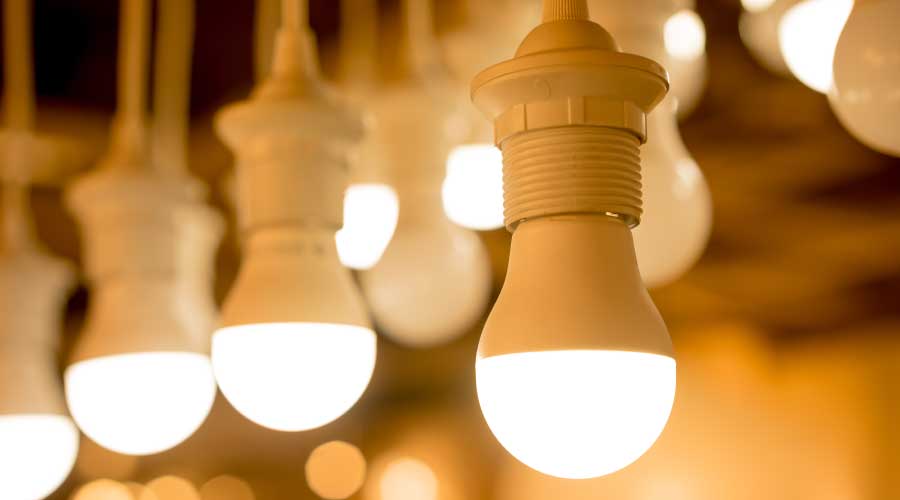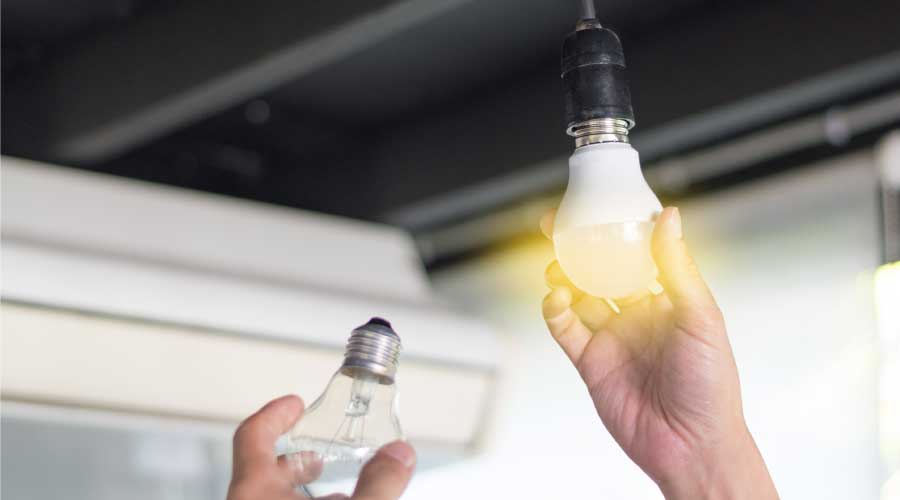 In the evening, an alerting stimulus can be delivered to office workers without disrupting their melatonin cycles via a desktop light therapy box emitting a low level of red light. The effect from this alerting stimulus would be similar to drinking a cup of coffee.Lighting Research Center at Rensselaer Polytechnic Institute
In the evening, an alerting stimulus can be delivered to office workers without disrupting their melatonin cycles via a desktop light therapy box emitting a low level of red light. The effect from this alerting stimulus would be similar to drinking a cup of coffee.Lighting Research Center at Rensselaer Polytechnic InstituteLighting Focused on Occupant Health and Well-Being
More and more research is showing how so-called "human-centric" lighting can have positive effects on worker mood, productivity, and other positive benefits.
Lighting for the built environment typically has been designed, specified, and manufactured to meet a relatively limited number of very specific objectives. Historically, the primary requirement of lighting has been that it should illuminate spaces to optimize visual performance (addressing concerns such as efficiency, productivity, and safety), provide visual comfort to occupants, and enhance the space’s appearance for aesthetic appreciation. Over time, increasing energy demand and costs led to the adoption of energy conservation as an additional requirement.
A newly burgeoning lighting industry initiative is human-centric lighting, also referred to as circadian-effective lighting. Based upon relatively recent developments in biophysical and lighting research, this approach focuses on how light’s non-visual characteristics can affect human health and well-being. By taking these characteristics and effects into account and recognizing their value, human-centric lighting promises to improve alertness, cognitive performance, sleep, and health while also benefitting a person’s mood, energy levels, relaxation, and even impulse control. Evidence shows that at least some of these goals can be achieved by lighting that works in harmony with our circadian rhythms, which are primarily synchronized to the environment by patterns of light and dark reaching the back of our eyes.
As the term has come into currency over the past decade, many European manufacturers have added human-centric lighting to their product offerings. LightingEurope, a trade association based in Brussels, earlier this year predicted that human-centric lighting will establish itself as the leading sector of the lighting industry by 2025. The term is also becoming more common in the United States, and it is likely that we will see a growing number of options for circadian-effective lighting in the coming years.
What’s more, advances in LED technology have made possible new approaches to lighting for healthy outcomes. For facility managers considering LEDs, the possibility of human-centric applications is another reason to be aware of the emerging concept.
But precisely what is human-centric lighting? What scientific research is it based on? What promises does it make, and can those promises be kept? For facility managers, now is a good time to understand why human-centric lighting is generating such interest.
Light and circadian rhythms
Almost every living thing experiences internal biological cycles that repeat themselves on a daily basis. Among these cycles are circadian rhythms, which in humans cycle at a period of about 24.2 hours (on average) and include all of our metabolic, physiological, psychological, and behavioral processes. Research has shown that the daily pattern of light and dark received by our retinas regulates many of our circadian rhythms, providing external cues that continuously synchronize (or entrain) our internal biological clock’s 24.2-hour cycle with the 24-hour cycle of the solar day. Misalignment between circadian rhythms and local time, as might occur between our preferred sleep patterns and work schedules or air travel across several time zones, can lead to health problems such as sleep disturbances, depression, diabetes, obesity, cardiovascular disease, and cancer. Laboratory and field studies have demonstrated that light–dark exposures at the right time can be used to remedy these circadian disruptions and reduce associated risks to our physical and emotional health.

(Programmed tunable-white LED lighting systems can deliver custom doses of circadian stimulus by adjusting light levels and CCT throughout the day. High stimulus should be delivered early in the day, and lower stimulus should be delivered at the end of the day through bedtime. The specific schedule shown here is an example, and should not be interpreted as a general lighting prescription. Source: Lighting Research Center at Rensselaer Polytechnic Institute)
Circadian system synchronization (or entrainment) is influenced by four key lighting factors: the timing and duration of light exposures, an individual’s personal history of exposures, the spectral properties of the light experienced, and the amount or level of light received at the eye. The human visual system responds in a similar way to the same light stimulus at any time of day or night, so activities like reading a book are reliably consistent around the clock. But the same light stimulus will have different effects on our biological clock when applied at different times of day.
Exposures to light in the morning and first half of the day, for example, can advance the circadian system’s schedule (or phase) over time, resulting in earlier sleep and wake times. Light exposures in the evening and first half of the night, on the other hand, can delay our circadian phase and result in later sleep and wake times. Because the human circadian system is maximally sensitive to short-wavelength (“blue”) light, moreover, exposures to light from this range of the spectrum are more effective at stimulating the circadian system than exposures to the same amount of longer wavelength light. In other words, less blue light is needed to affect our biological clock than any other type of light. Research has shown that light, especially blue light, exerts a strong influence on the body’s levels of the hormone melatonin, which is produced in darkness during sleep. Melatonin is a timing messenger to the body that helps to regulate our various circadian rhythms, such as the sleep and wake cycle, and is known to play a role in maintaining the health of our metabolism and its various processes.
Lighting for health and well-being
If traditional lighting design has taught us anything, it is that there is no universal lighting specification that will meet the needs of all people at all times, and the same lesson applies to lighting for health and well-being. Research has shown that the lighting requirements of shift-working nurses, for example, are quite different from those of adolescent school students, who require high levels of blue light early in the day to promote circadian entrainment but spend most of their daytime hours in dimly lit indoor environments. As a result, adolescents can be chronically sleep deprived, and exposure to blue light in the evening from electronic devices only compounds the problem, making it even more difficult for them to fall asleep and wake up early for school the next day.
Nurses who work the night shift, on the other hand, also need to regulate their light exposures to maintain healthy melatonin cycles but nonetheless require sufficient nighttime light to keep them alert and permit the performance of critical visual tasks like inserting an IV cannula. The nurses’ patients will have different lighting needs yet again, especially if they are older adults with Alzheimer’s disease and related dementias. Research focused on these older adults has shown that providing high circadian stimulus during the day and low stimulus at night resulted in improvements to sleep, depression symptoms, and agitation.
A considerable body of research to date has examined healthy lighting for office workers, who also benefit from lighting that provides higher amounts of stimulus to the circadian system during the daytime. It is generally agreed that lighting designed to promote circadian entrainment in daytime office workers should result in improved sleep, mood, health, alertness, and perhaps performance. Researchers at the Lighting Research Center at Rensselaer Polytechnic Institute recently conducted a study funded by the General Services Administration in five office buildings that confirmed this hypothesis, showing that office workers who received high circadian stimulus in the morning reported better sleep and diminished symptoms of depression compared to those who received low circadian stimulus in the morning.
The research to date shows that it is extremely important to tailor lighting systems that meet the circadian needs of the people who occupy any given space. Assessing the needs of any given population is therefore a key first step in providing a regular 24-hour pattern of light and dark to improve their health and well-being.
Related Topics:














